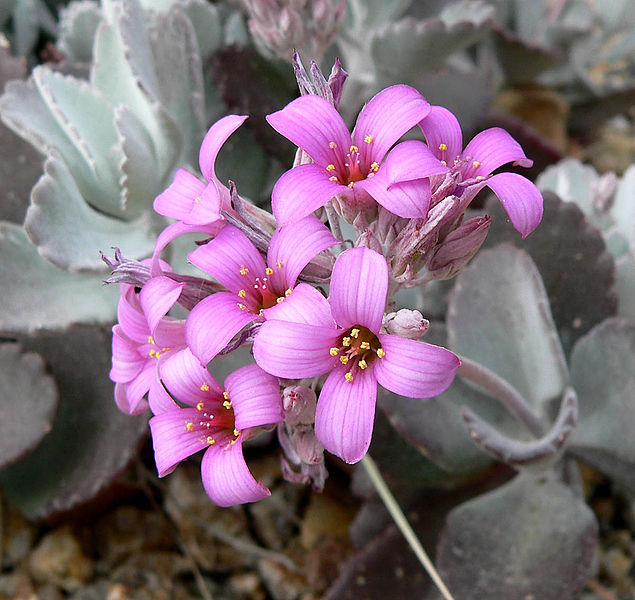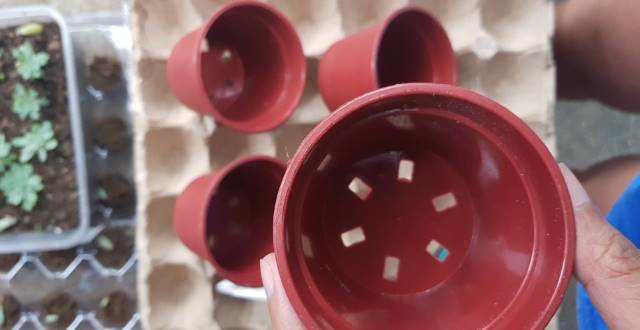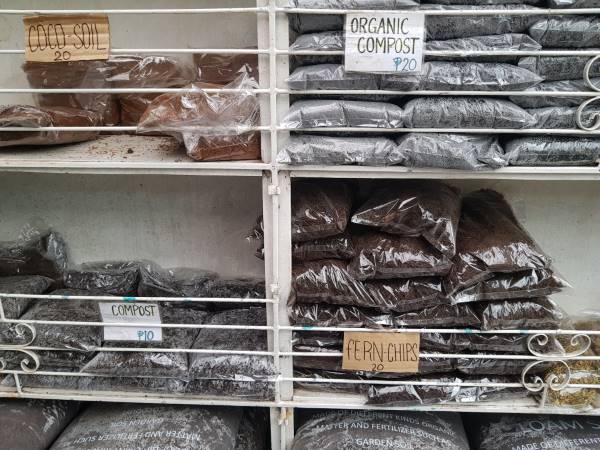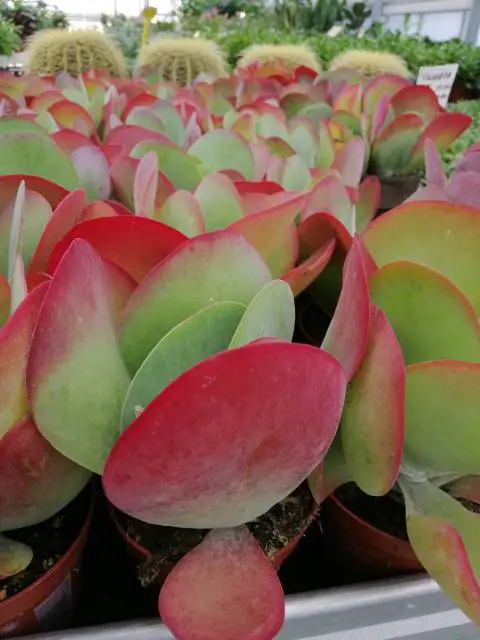Kalanchoe pumila is a dwarf flowering succulent that belongs to the Crassulaceae family. The epithet ‘pumila’ is a Latin word which means dwarf or slow-growing. It is a perennial succulent that is very easy to grow and does not require much care and attention. For busy gardeners, Kalanchoe pumila is one of the great options.
It is very rewarding for its beautiful blooms. It can be a perfect addition to hanging baskets and rock gardens. This succulent has a trailing or mounding growth habit and looks great in hanging baskets.
Kalanchoe pumila is commonly known as ‘Flower Dust Plant’.
Synonyms: Kalanchoe brevicaulis, and Kalanchoe multiceps
Kalanchoe pumila Origin
It is native to the Rocky Mountains of Madagascar, a large Island in Southeast Africa. Most of the Kalanchoe succulents have a common origin. They were moved to and cultivated in different regions of the world due to their ease of cultivation.
Kalanchoe pumila has received the Award of Garden Merit by the Royal Horticultural Society. This prize is given to plants that are easy to grow and are easily available. Usally plants with the best “garden value” get it.
General Features of Kalanchoe pumila
It is a shrub succulent with a trailing and spreading growth habit. It grows to a length of 8 to 12 inches (20 to 30 cm) and 1 to 2 feet (30 to 60 cm) in width. It looks amazing trailing from the hanging baskets and gives a captivating display to the home gardens. It also looks enchanting as a ground cover.

Leaves
This succulent has arching stems densely covered with round 1 to 1/2 inches long leaves. Leaves are silver grey with a rosy tint. The leaves have toothed margins and covered with whitish waxy hair that are very soft and give a frosted appearance to this succulent.
Flowers
Flowers are bell-shaped pink violet ¼ inches long with distinct yellow anthers. The flowers are held erectly on the stems.
Blooming season
The beautiful pink flowers bloom from late winter to early spring. They brighten up the silvery foliage of Kalanchoe pumila with their pretty color. The bloom attracts butterflies, bees, and birds.
Is Kalanchoe pumila an indoor or outdoor succulent?
The indoor and outdoor cultivation of Kalanchoe pumila depends on temperature. It is adaptable as a houseplant and widely grown. It can be grown outdoors in those regions where it is a hardy succulent.
How to Care for Flower Dust Plants?
Soil mix
Kalanchoe pumila needs a well-draining soil mix. Use a standard succulent potting mix or a normal potting mix containing pumice, perlite, compost, and more sand. The addition of sand and perlite improves the drainage potential of the potting medium and prevents soil compaction. They like to grow at a soil pH of 5.6 to 6.5.
Temperature
Kalanchoe pumila prefers to grow at a warm temperature and is very sensitive to frost. The minimum temperature for their growth is 12 °C (54 °F).
If there is a risk of freezing temperatures bring the potted succulents indoors and place them near a sunny window or artificial grow lights. They will not survive frost at all.
If you are growing kalanchoe succulents outdoors you must protect them from frost otherwise they will be killed in no time. You can use frost protection cloths to cover your succulents.
Hardiness zones
The USDA hardiness zones where Kalanchoe pumila can be grown as a hardy succulent include USDA zone 9a to 11b where the temperature is suitable for their outdoor cultivation.
Light requirements
Kalanchoe pumila prefers bright sunlight to partial shade. Keep the indoor succulents near a bright sunny window for 5 to 6 hours a day. If you do not have sunny windows at your place artificial grow lights will also work.
Proper exposure to light will avoid the etiolation of stems. Poor light exposure can also force your succulent to grow taller and weaker in search of a light source.
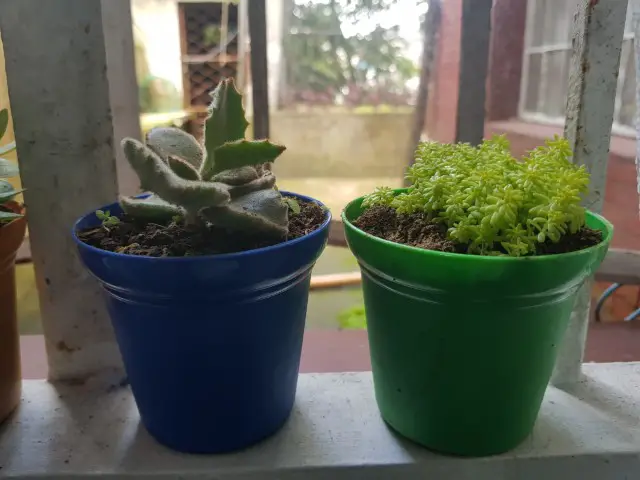
Outdoor succulents must be planted in partial shade where they receive plenty of indirect sunlight. Don’t leave your succulent under direct intense sunlight it can cause sunburn or sunscald.
How much to water your Kalanchoe pumila
Kalanchoe pumila is a desert succulent and does not require too much watering. Watering once a week is usually recommended. However, watering needs vary with seasonal changes and the type of Kalanchoe succulent. In summer the water evaporation rate is high and the water is lost quickly so they need to be watered more often. While they should be watered less sparingly in the winter season when the evaporation rate is too low.
Kalanchoe pumila should be watered using the soak and dry method. Water your succulents thoroughly until the soil becomes moist and allow the soil to dry before the next watering. Check the soil if the upper 1 to 2 inches are still moist you should wait until it dries out completely.
Can Kalanchoe pumila tolerate overwatering and underwatering?
No, Kalanchoe pumila will grow healthy as long as its basic water needs are fulfilled.
More about Kalanchoe Succulent watering here:
https://kalanchoe-succulent.com/when-to-water-kalanchoes/
Do not overwater because they can’t tolerate standing water and it can kill the plants. Excess of water causes disintegration and rotting of roots. Overwatering will also increase the chances of fungal infection.
Though they are drought-tolerant, they can’t go without water for a long time. So you should not leave your succulents without water for a prolonged time.
What are the signs of water distress?
Overwatered Kalanchoes will display soft mushy leaves that will become translucent.The leaves of an underwatered succulent will appear wrinkled, shriveled, soft, and flat.
If you observe any of these signs immediately bring your succulents back to normal watering regimes.
Humidity
Kalanchoe pumila does not require specific humidity. It can generally take all levels of humidity and is quite tolerant of high humidity.
Fertilization
Like other Kalanchoe succulents, Kalanchoe pumila also gets plenty of nutrients from the potting medium and does not need extra nutrients.
To make your succulents grow luxuriously, you can feed them biweekly in the summer season with a balanced liquid fertilizer.
Fertilization will give some extra nutrients for better blooming and growth in the upcoming season. Make sure do not give an excess dose of fertilizers to your succulents it can damage their health.
How to propagate Kalanchoe pumila?
Propagation is a great way to multiply your existing succulents without buying a new one. Kalanchoe pumila can be propagated easily through stem or leaf cuttings.
How to take cuttings? Remove the stem or leaf parts of the succulent with a clean scissor. Cut the leaves in such a way that no part of it remains on the stem otherwise you will have fewer chances of success. Snip off the stem for propagation as desired. Place the stem and leaf cuttings to dry at a warm place and develop callous for 2 to 3 days.
How to propagate? Fill the pots with a standard succulent or cactus potting mix. Place the calloused cuttings in the moist potting medium and gently firm the soil around. For the first few days keep misting the cutting 5 to 6 times a day regularly. Avoid exposure to direct bright sunlight. Once the cuttings are established in the soil and start rooting cut short the water supply.
When the plants are established in the soil water normally as you do for a full-grown Kalanchoe succulent.
Does Kalanchoe pumila need repotting?
Flower Dust Plant does not need repotting frequently. Generally, it should be repotted every 2 years. Repotting will provide the succulent a fresh growth medium with more nutrition and good drainage.
Make sure you repot your Kalanchoe succulent when you purchase it from a local market to provide a well-draining potting mix and better containers.
What is the process of repotting? Carefully remove the plant from the potting medium and shake off the excess soil adhering to it. Fill clean clay pots with succulent potting mix and transfer the succulent in this growth medium.
Check our article about repoting here:
https://kalanchoe-succulent.com/when-and-how-to-repot-kalanchoe-succulents/
Don’t water for a few days and let the roots recover. After 4 to 5 days water your succulents and care for them until they become established.
Does Flower Dust Plants require pruning?
Flower Dust Plants don’t need frequent pruning.
You can trim your succulents as desired to make them look neat and organized. You can also remove dead leaves and spent blooms. The removal of spent blooms will promote more blooming in the next season.
Don’t trim your plants very often it will make them weak.
How to do pruning of succulents?
Take clean gardening shears or scissors. Rub the tools with alcohol to avoid the possible risk of infection through contaminated tools. Cut the desired plant part gently. Make sure you only cut the unwanted plant parts.
Which pots are suitable for growing Kalanchoe pumila?
Clay pots or glazed ceramics are very good for growing Kalanchoe pumila because they have good drainage. Avoid using glass containers or black plastic pots because they have poor drainage and absorb more heat.
How to make Kalanchoe pumila bloom again
Most of us discard our Kalanchoe succulents once they are done with blooming. For many gardeners discarding their plants is always a painful experience. But instead of throwing your succulents, you can make them bloom again.
Just snip off the flower heads after the blooming season is over. Let the plant rest for a while by cutting short the water supply. When the rest period is over resume normal care for your succulents. They will start blooming naturally in the spring season. In this way, you can make your Kalanchoe succulents blooming for years.
Many professional growers force their Kalanchoe succulents to bloom throughout the year.
What are the potential insect pests and diseases of Kalanchoe pumila?
Kalanchoe pumila can be attacked by mealybugs and aphids. Both insects love to suck the sap from the succulents and make them weak.
Slugs and snails are also frequently observed in outdoor succulents. Slugs and snails can permanently damage the leaves.
Powdery mildew and rust are the common fungal diseases of Flower Dust Plants. Powdery mildew is recognized by the appearance of white powdery substances on the leaves. Rust is characterized by rust-colored pustules on the leaves or other plant parts.
How to get rid of insect pests and diseases?
Regularly inspect your succulents for general health problems.
If you spot a few insect pests you can easily remove them by picking. In case the infestation is high rub the plant parts with 70 % isopropyl alcohol or use a neem oil spray to get rid of the mealybugs and aphids. You can also use a recommended nontoxic pesticide to kill the insects.
Place some crushed eggshells or diatomaceous earth around the base of the succulent to get rid of snails and slugs.
Avoid overwatering to prevent fungal decay of the roots.
Is Kalanchoe pumila suitable for xeriscaping?
Kalanchoe pumila is a drought-tolerant succulent that makes it perfect for xeriscaping. It is easily available and does not require too much care. So if you don’t have too much time to check on your scape, it is perfect.
Is Kalanchoe pumila toxic?
Yes, Kalanchoe pumila is toxic to pet cats and dogs. It might not be good news to Kalanchoe succulent lovers who also love to keep pets at home.
Unfortunately, its roots, stems, leaves, and flowers all are toxic but flowers are the most toxic parts.
If your pets have a habit of chewing up the plants keep these succulents out of their reach. They contain cardiac glycosides which can be fatal to the pets. The pet may experience a change in heart rate, stomach upset, diarrhea, and excessive salivation.
In case your pet ingests any part of the succulent, seek medical advice from an expert Vet immediately.
From where to buy Kalanchoe pumila?
You can purchase Kalanchoe pumila from a local nursery or plant market easily. You can also buy this lovely succulent from online shopping websites e.g., Etsy and Amazon. They will deliver your favorite succulent at your home.
Which plants are perfect to grow along with Flower Dust Plant?
Flower Dust plant makes perfect arrangements along with Sedum species, Echeveria species, Sempervivum, Aeonium, and Graptopetalum. You can grow these plants in combination to give a great display to your succulent gardens.
Featured Image Credit: Stan Shebs / CC BY-SA

